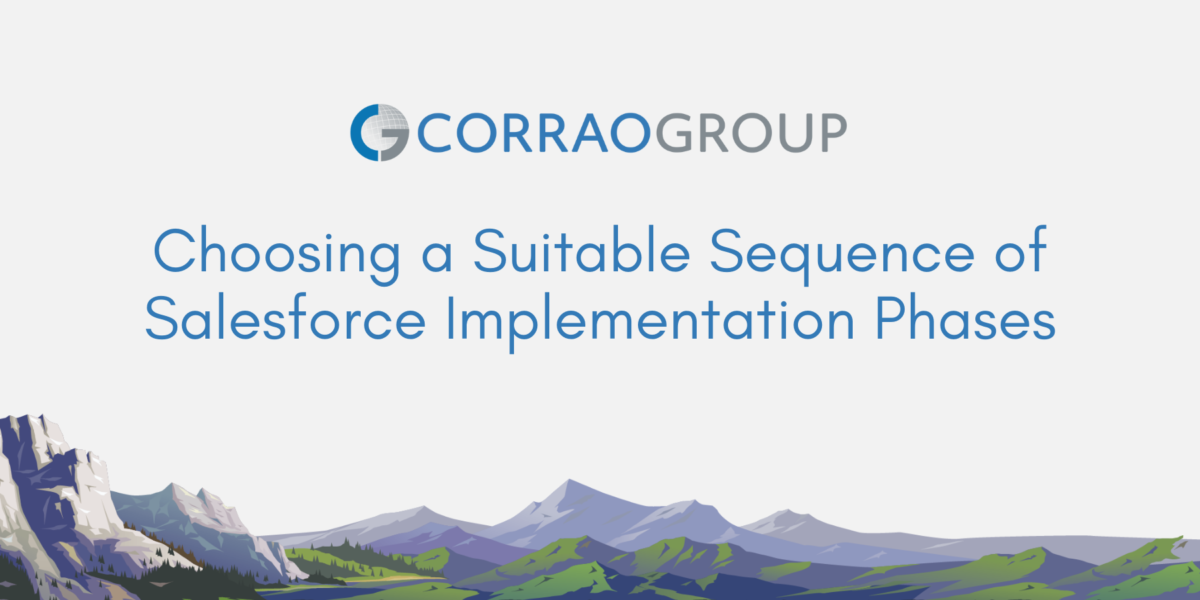In part 4 of our blog series, we mentioned how working with a Salesforce consulting partner is the best route for success. It’s now time for your partner to take you through a suitable sequence of implementation phases. Salesforce is best implemented in phases, setting up and training users from each department. Doing so helps boost user adoption and allows for the correct transfer of business processes into Salesforce. Making sure each department is set up on Salesforce before moving onto the next department is key to a successful implementation.
Implementing Salesforce in Phases
Before diving into the implementation, it’s crucial to take the time to map out all your business processes and core KPIs. These KPIs could be based on revenue, tasks, service, sales, or more. Understanding the current pain points of your organization will help ensure Salesforce is customized and maximized to ensure business success. With an entirely new platform, Salesforce can become overwhelming to your users because of its flexibility. The phased approach for implementing Salesforce allows your users to ease into the platform and ensure adoption.
Best practices for implementing Salesforce in phases include:
-
- Phase 1: Migration of current systems. Quick and efficient phase. Best practices include importing your data to start managing the data based on Salesforce stages, activities, and emails. In this phase, it’s important to have your managers engaged and using the system’s features such as reports and dashboards, leads, contacts, tasks, and more. A good partner will have your Salesforce set up in about 3 months with training to help your users adapt to the new platform.
- Phase 2 and 3: Integration of legacy systems. These phases are typically “bolt-on” expansions where you should integrate your accounting system, databases, or in-house systems. Phases 2 and 3 offer you the best way to take advantage of the vertical applications Salesforce has. Best practices include creating a 2-year roadmap that will allow you to plan and track progress as you expand and install different databases.
Phased Approach
-
- Map out and Optimize Business Processes
- Identify all business processes and how they possibly intertwine when mapping out your company’s processes. Interview key stakeholders to make sure nothing is missed. Take this time to review any outdated processes and how they can be improved, both with and without Salesforce.
- Create a Salesforce Implementation Plan
- Salesforce recommends a certified consulting partner for both new and existing customers to help with implementation. An expert knows which features out of the thousands that Salesforce offers will best help your company without wasting any time or money. They work with you to build out a phased implementation approach to ensure maximum success and adoption. At Corrao Group, we’ve been optimizing the business processes of all industries since 2002 and ensuring their successful transition into Salesforce.
- Implement Salesforce and Ensure User Adoption
- Follow your implementation plan, making sure users are aware of what has been set up. Training should be held walking through all users of the new system and how their specific processes are carried out going forward. A learning curve is expected, but your users will start to come up with suggestions on how to improve the system, making it more custom to your business. Once one department has been set up and trained, it’s time to repeat until your implementation plan is complete.
- Map out and Optimize Business Processes
The COVID-19 pandemic has proven that you need a cloud-based system that is flexible to your ever-changing business processes. If you need help implementing Salesforce, please contact us.
About Corrao Group
Since 2002, we have been helping B2B organizations of all sizes optimize their business processes with Salesforce and their third-party applications. As everyday Salesforce power users, Corrao Group understands how flexible the Salesforce platform is to support every business department. We’ve worked with nearly 1,000 customers, implementing, customizing, and optimizing over 2,100 Salesforce projects. If you are interested in learning more about how Corrao Group can help your company, read our reviews on G2 or contact us today!
Sources/Photos
-
-
- Salesforce Photos/Characters
-

